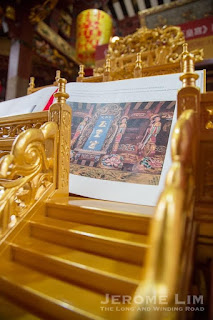《联合早报》- 记载新加坡道教史和玉皇宫修复过程 道教协会新书《受禄于天》发布 (2020-07-27)
记载新加坡道教史和新加坡玉皇宫修复过程的《受禄于天:走进新加坡玉皇宫》,原定于今年3月7日道教节时推出,但因冠病疫情展延至上周六(25日)正式发布。
新书是新加坡道教协会为配合新加坡玉皇宫开宫五周年及庆德会成立188周年出版的,道教协会会长兼玉皇宫住持李至旺致词时说:“基于安全距离等方面的限制,发布会可邀请的嘉宾有限,但我们首次尝试面簿同步直播,算是一次国际性的新书发布会。书名取自新加坡玉皇宫前身庆德楼内的‘受禄于天’牌匾,寓意一切福禄源自老天,秉持中正信念,就能获得老天的眷顾。”
新加坡玉皇宫位于直落亚逸街天福宫隔邻,由1831年36名土生华人组成的闭门组织庆德会所修建,供奉玉皇上帝和三官大帝。庆德楼向来不对外开放,2010年由新加坡道教协会接管后易名新加坡玉皇宫,2012年斥资380万元整修,2015年向公众开放。
新书共有四个章节——吾道其南、受禄于天、古迹新颜,以及回首前尘。全书超过250页,照片400余张,由本地历史学者柯木林主编,并由多名国内外学者担任编委。新书属非卖品,捐款200元以上获赠一本精装版,捐款2000元以上获赠豪华版(书名以庆德楼180年古木雕刻而成),有兴趣者可致电62256112/3询问。
土豆 - 《受禄于天 - 走进新加坡玉皇宫》新书介绍
https://video.tudou.com/v/XNDc0MjY0NjM3Mg
《受禄于天 - 走进新加坡玉皇宫》新书介绍 TAOIST CULTURE IN SINGAPORE : A LIVING TRADITION 新书发布会: 25-07-2020 OFFICIAL LAUNCH: 25-07-2020 本书内容
Content 四大部分 4 Main segments 。第一章 吾道其南 Taoism in Singapore 。第二章 受禄于天 “Blessings” from Heaven 。第三章 古迹新颜 Reviving our heritage 。第四章 回首前尘 A walk down memory lane 三个附录 3 Appendixes 多名学者参与,是学界和宗教界的跨界合作成果 A joint effort by scholars and collaborations between the academic and religious fields. 海内外道教研究的学者撰文,是少有的系统研究本地道教的著作 Collections of Taoism research articles by overseas and local academia. A rare publication containing a systematic research findings of local Taoism. 详细记录国家古迹庆德楼的修复过程 Detailed documentation of the restoration of the national monument – the former Keng Teck Whay building. 本书为非卖品。 只赠送给捐助者。凡捐助$200 或以上者可获得一本精装本。 赠完为止! Publication is not for sale, however, every donation of $200 and above entitles a complimentary standard edition in support of the publication project. While stocks last!
《联合晚报》- 新加坡道教协会新书发布会《走进新加坡玉皇宫》明年3月正式面世 (2019-12-03)
《联合早报》- 道协明年出新书 记载玉皇宫修复过程 (2019-12-04)
https://www.zaobao.com.sg/news/singapore/story20191204-1010429
配合新加坡玉皇宫开宫五周年及庆德会成立188周年,新加坡道教协会明年将出版新书《受禄于天:走进新加坡玉皇宫》,记载玉皇宫的修复过程及学者研究本地道教文化的成果。
位于直落亚逸街天福宫隔邻的玉皇宫,前身是属于庆德会的庆德楼。庆德会是在1831年由36名土生华人组成的闭门组织,会员都是信奉道教的土生华人,修建庆德楼是为了供奉玉皇上帝和三官大帝。庆德楼一向不对外开放,2010年由新加坡道教协会接管后,易名为新加坡玉皇宫,同时作为新加坡道教协会会所。2012年,道教协会斥资380万元整修玉皇宫,并在2015年决定把修复后的玉皇宫向公众开放。
新加坡道教协会会长兼新加坡玉皇宫住持李至旺昨天在记者会上表示,玉皇宫的修复过程艰辛,尤其因建筑的左右空间有限,工程必须以垂直方式进行。新书《受禄于天:走进新加坡玉皇宫》详细记录庆德楼蜕变为玉皇宫的历史事迹和修复过程,由本地知名历史学者柯木林主编,以及多名国内外学者担任编委。
新书共有四个章节——吾道其南、受禄于天、古迹新颜,以及回首前尘。全书约250页,共有409张照片。
柯木林提到这本书的特色时说:“它是少有的系统性研究本地道教的著作,由海内外道教研究学者撰文。书中以大量照片对比庆德楼修复前后,是重要的历史建筑记载。书名取自庆德会的“受禄于天”牌匾,新书的豪华本书名也用了180年古木雕刻而成,非常有意义。”
新书在最后筹备阶段,准备在明年3月7日道教节时推出,预计印刷1300本,1000本为精装本、300本为豪华本。新书是非卖品,捐款200元以上将获赠一本精装本、捐款2000元以上将获赠豪华本。有兴趣者可致电62256112/3询问。
李至旺指出,新书出版费用高达17万9500元,国家文物局赞助6万多元。目前信众已乐捐8万多元,仍需弥补3万多元差额并筹集玉皇宫的运作经费。
958 - 道教协会明年将推出书籍 记录庆德楼蜕变为玉皇宫的修复过程和道教发展
https://omny.fm/shows/capital-958m/03-12-2019
Straits Times - New chapter for temple (2019-12-07)
Straits Times - Taoist Mission to publish book documenting restoration of building housing the Singapore Yu Huang Gong
SINGAPORE - Just six months after moving into their new home in Telok Ayer Street in 2010, the Taoist Mission (Singapore) had to move out.
The Keng Teck Whay building - built in the 19th-century and gazetted as a national monument in 2009 - was declared unsafe for occupancy after a picture showing its damaged roof rafters appeared in Chinese daily Lianhe Zaobao.
This marked the start of a four-year long preservation project which cost around $3.8 million and transformed the Keng Teck Whay building into Singapore Yu Huang Gong, or Temple of the Heavenly Jade Emperor, in honour of the highest deity in Taoism. The temple was opened to the public in 2015.
This restoration process will now be documented through a collection of 200 photographs in a book the Taoist Mission is launching in March next year, it announced on Tuesday (Dec 3).
The Taoist Mission, which promotes orthodox Taoist teachings and disciplines, was founded in 1996 and currently has 18 management members.
Titled Heavenly Blessings, the book also includes information about Taoism, its culture in Singapore, and the history of Keng Teck Whay, a private mutual aid Hokkien Peranakan organisation first established in 1831.
Only 1,600 copies will be printed, of which 300 will be luxury editions bearing title plaques inscripted on slabs of partially damaged wood removed from the building during its reconstruction.
The Taoist Mission hopes that the book, a recipient of the National Heritage Board's (NHB) Heritage Project Grant, will be a useful resource for people interested in traditional Chinese architecture.
As the former Keng Teck Whay Yu building is a National Monument, it had to be restored in exact accordance to its original design.
For example, the intricate, polychromatic paintings adorning the temple's doors and wall panels are a distinct feature of the architectural style in Quanzhou, Fujian province, and a team of artists from the region were flown in to restore the drawings and murals to their original splendour.
The team also worked on the ornamental sculptures of dragons, fishes and flowers on the roof ridges, which were made using the jian nian (cut and paste) technique.
The roof of Singapore Yu Huang Gong, which features ornamental sculptures of dragons, fishes and flowers made with the jian nian (cut and paste) technique. PHOTO: TAOIST MISSION (SINGAPORE)
It also had to deal with structural damage to the building, which was mainly due to termite infestations and the rotting of wood.
True to the traditional Hokkien style, the building was constructed entirely from interlocking beams of timber, without the use of nails.
"The beams are stacked like Lego," said Master Lee Zhiwang, President of Taoist Mission. "We removed each piece from the top to the bottom, replaced the damaged ones, and then assembled them again."
The roof of Singapore Yu Huang Gong, which is built in the traditional Hokkien style, using interlocking beams of timber.
As Yu Huang Gong is sandwiched between a park and Thian Hock Keng temple, there was little space for heavy machinery and the construction team had to carry the beams in manually or up with a pulley system.
Taoist Master Lee Zhiwang, president of the Taoist Mission, said the former Keng Teck Whay building in Telok Ayer Street is steeped in history.
Related Story
Temple steeped in mercantile history
During the restoration, the team found the roof's original brown terracotta tiles, which had been hidden by layers of plaster and paint from repairs made over the years.
"It was an interesting discovery for us because everyone thought the tiles were glazed green," said Master Lee.
"We even had to send a piece down to NHB (National Heritage Board)'s Preservation of Sites and Monuments division to explain why we were reverting the colour of the roof to brown," he added.
《联合早报》- 张克润:从“庆德楼”到“玉皇宫” (2020-08-15)
https://www.zaobao.com.sg/forum/views/opinion/story20200815-1077089
2020年7月27日,耸立在直落亚逸街天福宫左侧的新加坡玉皇宫(原庆德楼),隆重举行《受禄于天——走进新加坡玉皇宫》出版及面薄同步直播仪式。
由新加坡道教协会出版、本地历史学者柯木林主编的《受禄于天》,其出版意义重大;内容分四个章节:“吾道其南”阐述新加坡道教史、“受禄于天”庆德楼的渊源、“古迹新颜”玉皇宫的修复及“回顾前尘”等。国立大学中文系主任丁荷生教授特别撰写《新加坡道教的跨文化力量》尤为出色,增添时代新意。
本书出版除了纪念188年前成立的庆德会,也庆祝玉皇宫开宫五周年纪念。庆德会是土生华人最早的互助会,它与恒山亭福德祠(1827年)及天福宫(1837年-1842年)的成立息息相关,为闽南漳泉移民星洲的先驱组织。庆德会原址地契于1831年获得,比隔邻天福宫地契来得早。庆德楼建筑造型及建材,与1848年建成的崇文阁完全雷同,可见建于天福宫两则的两座具山门及八卦亭塔楼建筑物的完成日期应该相近。
庆德楼年久失修,面对坍塌风险。新加坡道教协会在2010年3月31日获得庆德会理事同意,以象征性费用转让,并于当年12月28日得到当局批准,正式易名为“新加坡玉皇宫”。道协经过五年的抢救周折,在2015年完成国家古迹的翻新保护及举行开光庆典。
值得赞誉的是,2009年11月11日古迹保留署宪报保留庆德会为国家古迹之前,该署在2008年就开始监督勘察古迹翻新及支持翻新工程,确保庆德楼继续为传统道教礼仪使用地,并要求古迹对外开放。
这促使庆德会与道协达致协议,一座集山门、匾牌、亭塔底层供奉三官大帝和塔楼供奉玉皇上帝,及后院供奉祖先的漳泉风格宗祠建筑物,得到全面保护,并将延续在上元(正月十五)、中元(七月十五)、下元(十月十五)、清明及冬至祭祀祖先、三官大帝及玉帝的传统。
庆德会由36位马六甲土生福建家族成立,选举会主一人及谋事、参议等职员。入会须缴付100元救济基金,会员资格仅限创始人后裔,服务对象则包括家庭成员,不分姓氏,如遇某会员逝世或遭遇不测,其他会员须援助其家属,直至其子女成年自立。创会成员中有16位参与恒山亭的成立,及多位成员参与天福宫/崇文阁的建设管理。
如今,祠堂保留刻写开埠先贤杨金水、徐钦元、陈有郎及洪俊成等共35名“桃园结义兄弟”的碑文。可见,庆德楼意义非凡,代表与天福宫、崇文阁连成一气,为东南亚独一无二的中国南方传统庙宇建筑典范,成为市区重建局“唐人街历史分区”(Chinatown Historic District)核心地标,并见证团结福建华裔移民和福建会馆的成立。
天福宫及庆德会早在1973年被列为首批八大国家古迹,但其实两者业主不一。庆德楼只限对会员开放,长期关闭,业主资源萎缩,缺乏翻新,以致于2009年独立鉴定为国家古迹加以保护。
其塔楼底层供奉三官或三元大帝,即道教尊奉的尧舜禹三位建功天神,特指祭天地水的礼仪,象征天官赐福,地官赦罪,水官解厄。
塔楼上供奉玉帝全称“昊天金阙无上至尊自然妙有弥罗至真玉皇上帝”。唐代诗人白居易《梦仙》诗中就有“仰谒玉皇帝,稽首前至诚”的诗句。玉帝尊号始于宋徽宗政和六年,居玉清宫统领三界十方内外神佛仙圣。道教名言:“存心邪僻任尔烧香无点益;扶身正大见吾不拜有何妨”,众神领袖玉帝沉寂上百年后重现,彰显尊道贵德的因缘。
有如广州三元宫一样,新加坡玉皇宫的三官大帝,不仅代表中华古文化在新加坡的传承,而且代表崇拜天地水在原天然帆船停泊处——直落亚逸滨海水湾(Telok是海湾,Ayer是水)岸边汲水地落地生根,独特见证新加坡多元民族宗教和谐并存,成为和平教育的典范。
莱佛士登陆与苏丹胡赛因签订建立贸易站后,海唇福德祠、应和会馆(原祀关公)、粤海清庙、纳哥圣殿、庆德会、天福宫及阿尔阿布拉回教堂,成为莱佛士市区规划(Raffles Town Plan)中唐人甘榜(Chinese Campong)以东方建筑为主的宗教古迹区。
它们历经六次重大“移山填海”工程及市区重建的设立,受到不可逆转急速变化的破坏,代表新加坡海峡狮城港开埠系列建筑群和原古海岸景观的特殊范例,展示在人类已消失的帆船时代,巫华印民族汲水居住、祈祷立庙设冢使用地、贸易通商地及利用海湾环境移山填海发展商港,并嫁接轮船时代来临,独特及特殊传统生活区的见证。
道协接管庆德楼翻新为玉皇宫,独特凸显道教贵和尚柔,一方面传承华社社稷文教基石;另一方面成为多元种族、宗教与文化和谐相处,并相互交流影响的见证,突出代表人类和睦相处及宗教包忍的范例。
据道协会长李至旺道长反映,因缘于《联合早报》林妙娜报道:让他开始接触庆德会前会长蔡善启等理事,协商接管事宜;共筹集约400万元工程经费,完成抢救国家古迹的工程。
这座狮城最早期开埠时期的玉皇宫的修建,让华裔移民独特的传统文化得以传承发扬。庆德楼翻新竣工及欢庆玉皇宫成立,等于是庆德庆生,为新加坡核心古海岸系列宗教古迹增添灿烂的光华。
作者是南洋大学校友学术会副会长
文学与社科研究会主席兼新加坡文化遗产组组长
王鸾 - 读书






















